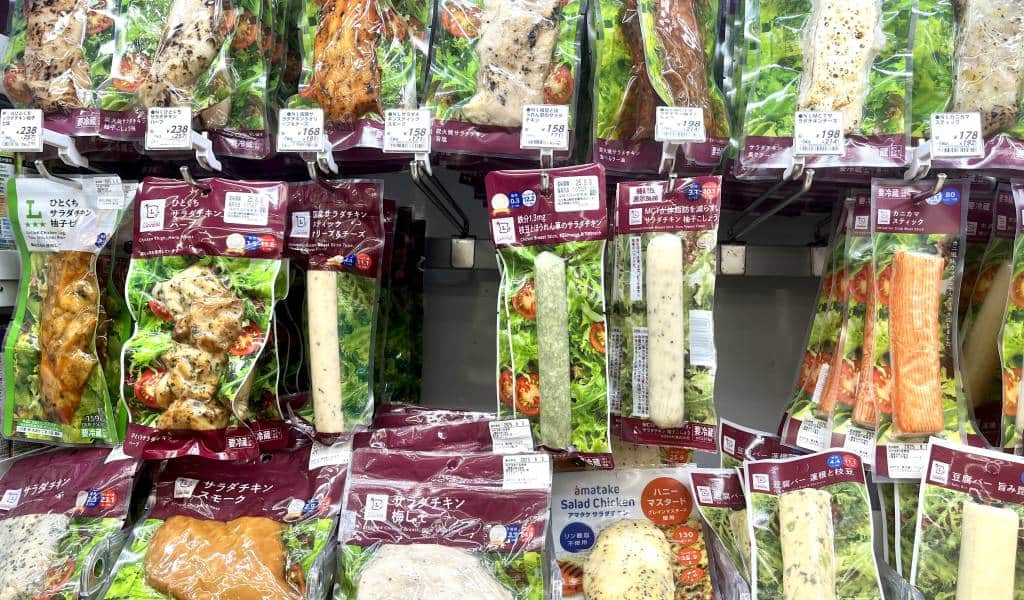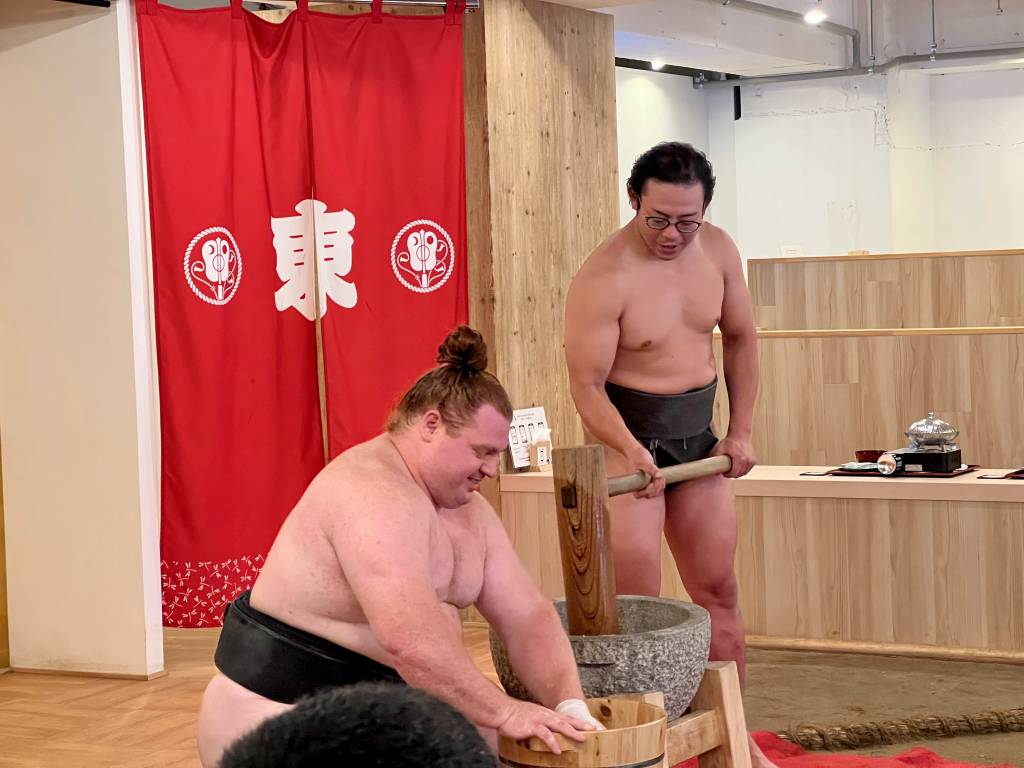Eating keto in Japan is impossible — or at least that’s what everyone says. With rice a national treasure and (delicious) sweetened sauces blanketing proteins and veg alike, we don’t blame you for being skeptical.
But there’s good news. You won’t have to live off boiled eggs and wishful thinking while in Japan (although they will be making an appearance). Beneath the carby surface lies a deeply savory, surprisingly keto-friendly food culture — one that’s worth exploring even if you’re on a diet. All it takes is knowing where to look and what to order.
So, whether you’re visiting for a week or staying longer term, here’s what you need to know about doing low-carb in Japan. There are no unseasoned chicken breasts involved, we promise.
Keto 101
Let’s go over the basics, before we get into what to buy.
What is keto?
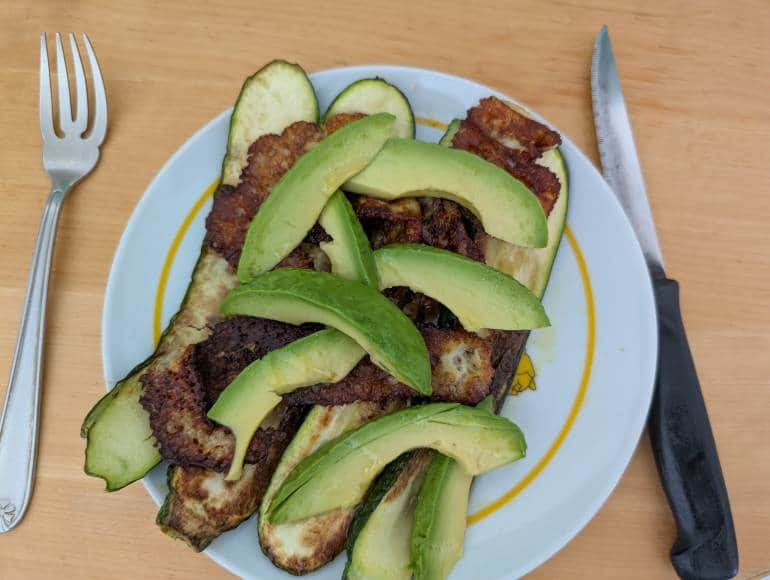
Broadly defined, keto is a low-carb, high-fat diet that skips sugar and starch in favor of protein, healthy fats, and leafy greens.
What does it look like in practice?
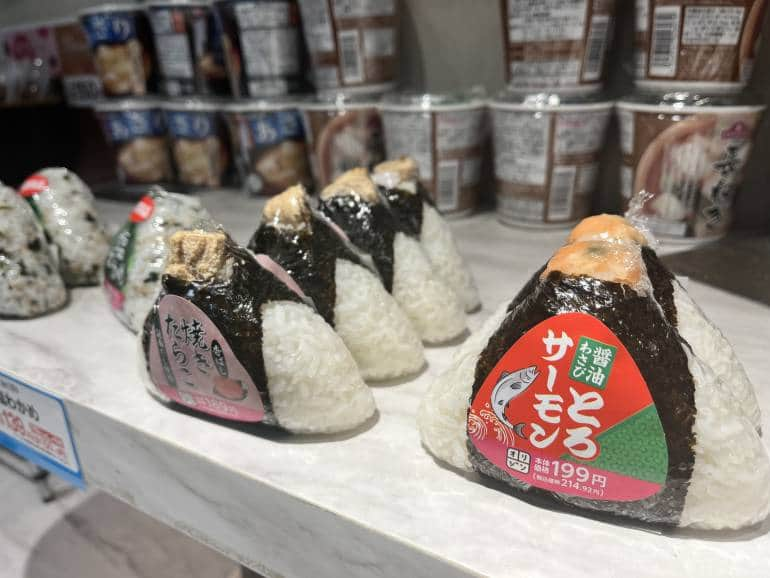
Every keto diet is individual. Typically, think no rice, no bread, no noodles, but plenty of grilled meat, oily fish, eggs, cheese, and non-starchy vegetables. This generally means limiting your daily carb intake to 50 grams or lower — although there may be less or more restrictive variations.
Why do keto?
The goal of keto is to move your body into a state of ketosis, where it burns fat for fuel instead of carbs. Some people opt for a keto diet for weight loss, while others may be after increased energy or focus.
Important: Please talk to a nutritionist or doctor before jumping on a keto diet. It needs to be done with caution, to be safe and healthy. It is definitely not appropriate for everyone.
What to eat
So, what can you eat in Japan while on a keto diet? While you won’t find “keto” printed on many menus, low-carb eating in Japan is very possible. The key? Knowing the principles. Keto-compatible dishes won’t announce themselves, but they’re often hidden in plain sight.
Japanese food
Here’s a list of popular Japanese food items — some with a twist — that won’t betray your carb count, and where to find them:
- 1. Sashimi
- 2. Yakitori
- 3. Yakiniku
- 4. Shabu-shabu
- 5. Nabe
- 6. Beef bowls
- 7. Japanese curry
- 8. Oden
- 9. Tofu
- 10. Ramen (with a big but)
1. Sashimi

Slices of raw, fresh seafood, served without rice, sauces, or embellishment — that’s sashimi. Each piece is typically cut with precision to highlight the texture and flavor of the fish.
In addition to the classic salmon and tuna slices, you’ll find fish like iwashi (sardine), hamachi (yellowtail), and aji (horse mackerel). Ask for sashimi moriawase for a variety plate. Avoid chirashi (scattered sushi) unless you can request no rice.
Where to go
Sashimi is available at sushi restaurants, seafood izakaya, department-store food halls and supermarkets.
2. Yakitori

Yakitori refers to grilled, skewered chicken. Especially keto-friendly cuts include reba (liver), bonjiri (tail), sunagimo (gizzard), and torikawa (skin). Avoid anything with tare (sauce that typically contains sugar) or wrapped in batter — that means no kushikatsu.
Where to go
Torikizoku: Found on just about every corner, Torikizoku delivers consistently solid yakitori without the guesswork. You won’t get the charcoal haze, cramped counter, or quirky banter from a whisky-soaked ojisan, but you will get decent skewers, cold drinks, and easy communication.
Yakitori Sumire: Another reliable brand with locations across Japan. Head here for a smooth, no-surprises dining experience every time.
Another chain to look out for is Yakitori Daikichi.
3. Yakiniku
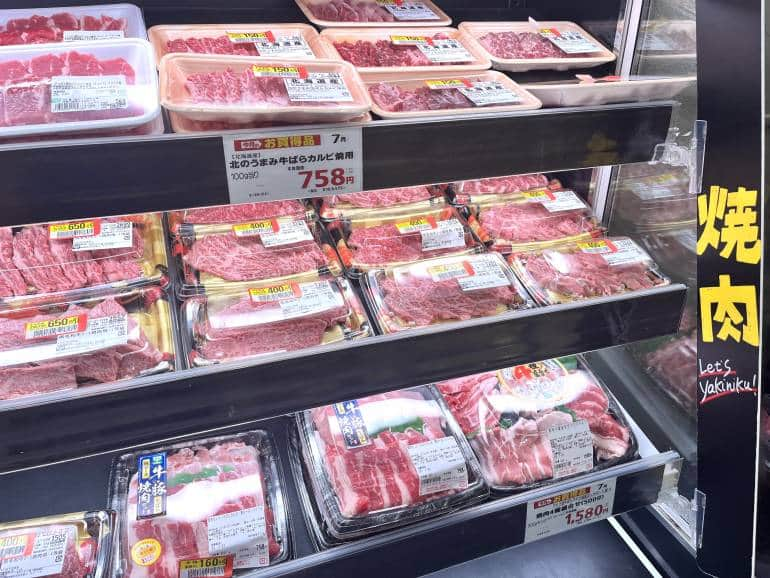
Japanese barbeque restaurants let you grill your own meat, giving you maximum control over cuts and seasoning for your keto diet. Choose fatty cuts like karubi (short rib), harami (skirt steak), or various types of offal. Ask for salt or lemon only, and skip dipping sauces unless you’re sure they’re sugar-free.
Where to go
Gyu-Kaku: One of the most accessible yakiniku chains around, Gyu-Kaku strikes a balance between casual and celebratory. The all-you-can-eat options make it a favorite for group dinners, while the quality holds up well. Think marbled cuts and decent sides, accompanied by that satisfying DIY sizzle at your table.
Yakiniku Like: Built for solo diners and busy schedules, Yakiniku Like delivers quick, smokeless grilling with good value. Individual roasters, touch-screen ordering, and tender cuts make it a go-to.

Kollabo: This is a Korean BBQ-yakiniku hybrid with keto-friendly options. Expect mid-range prices and an izakaya feel. There are locations across Tokyo, including Shibuya, Shinjuku, and Kichijoji.
Jingisukan Daruma: This spot serves cuts of high-quality lamb with seasonings you can modulate yourself. Grill on a dome-shaped skillet with cabbage and onion. Or head straight to the source in Hokkaido — see our Sapporo food guide.
4. Shabu-shabu:
Unlike other hotpots where everything simmers together, shabu-shabu is cooked piece by piece at the table, making it highly interactive and easy to control. Stick to fatty meats like pork belly or marbled beef, and load up on low-carb veggies like Chinese cabbage, mushrooms, and tofu. Avoid sweet sauces, pumpkin or kabocha, and starchy sides. Go light on dipping sauces.
Where to go
Check out our dedicated shabu-shabu in Tokyo guide.
5. Nabe
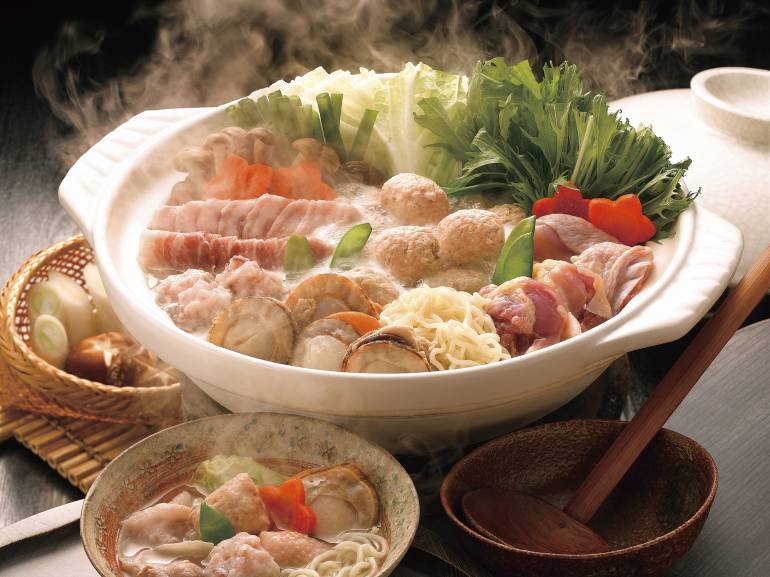
Nabe is another type of hotpot, but what sets it apart from shabu-shabu is that everything is stewed together. It’s a hearty and customizable winter staple, but actually enjoyable any time of year. For keto eaters, it’s one of the easiest traditional meals to adapt, because you can choose the ingredients and simply skip the noodles or rice.
Where to go
Our guide breaks down the different types of nabe and where to try them in Tokyo and beyond.
6. Beef bowls
Beef bowls or gyudon are a Japanese fast-food dish comprising thinly sliced beef and onions simmered in a mildly sweet soy-based sauce, served on white rice. These days, though, it’s possible to just order meat and sides.
Where to go
Yoshinoya: One of Japan’s oldest beef-bowl chains, Yoshinoya offers a gohan nuki (no rice) version of their beef bowl. The simmered beef does contain some sugar, but carb-wise it’s probably still manageable for most keto eaters. You can also add a soft-boiled egg or side salad to round it out.
Matsuya: Matsuya is especially keto-friendly thanks to their set meals that often include grilled meat, tofu, and side salads. You’ll find options that skip the rice.
6. Japanese curry

Japanese curry with rice is high in carbs in its standard form. But it’s possible, again, to drop the rice or sub it for something keto-friendly.
Where to go
CoCo Ichibanya: CoCo Ichibanya offers a cauliflower-rice option that swaps out regular rice for about 180g of diced cauliflower, bringing the carb count down to around 16g. You can customize your curry with low-carb add-ons like spinach, cheese, or boiled egg.
7. Oden

Oden is a simple stew. Choose daikon, boiled egg, konnyaku (a gluten-free, low-carb jelly-like food made of yam), and shirataki noodles (konnyaku shaped into noodles).
Avoid mochi-stuffed items. Fish paste-based items like hanpen, kamaboko and chikuwa would also exceed the carb threshold.
Where to go
Nabe is available in convenience-store hot cases (especially 7-Eleven in winter), izakaya, and specialty stalls.
8. Tofu and egg dishes

Try chawanmushi (savory egg custard), yudofu (simmered tofu in kelp broth), and hiyayakko (chilled tofu topped with scallion and soy sauce, a summer favorite). Avoid agedashi tofu, as it comes with a starch coating. On the other hand, fried tofu or abura-age is permissible, coming in at under 1g of carbs per 100g.
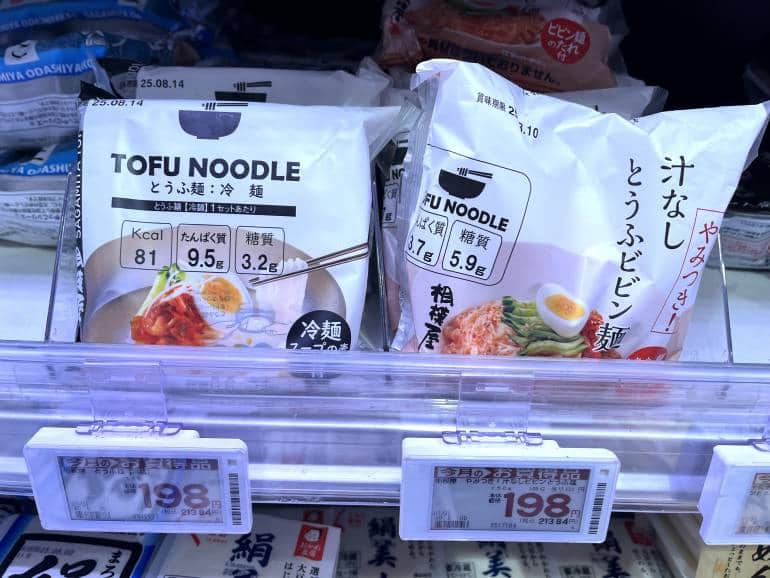
Some supermarkets may also sell tofu noodles. This type contains only 1.6g of carbs.
Where to go
Found at izakaya, restaurants, and some temple cafés.
9. Ramen
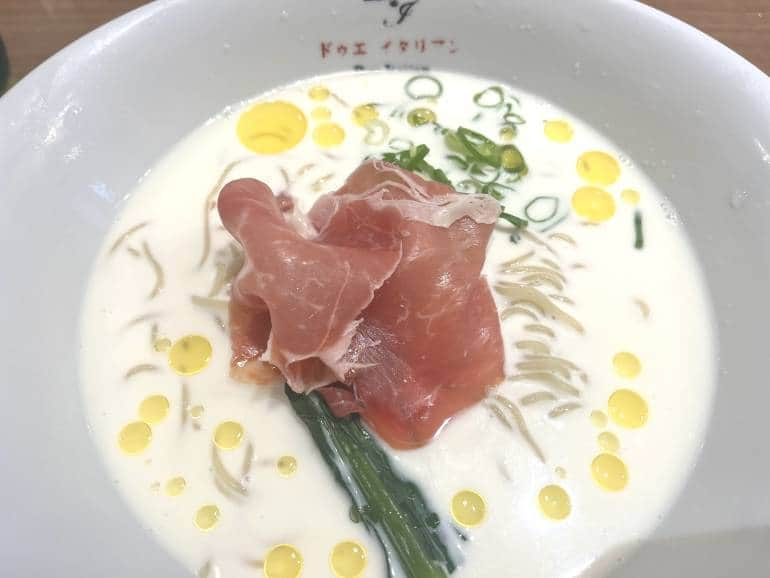
As iconic as it is, traditional ramen is far from keto-friendly, thanks to its wheat noodles. That said, if you’re craving a bowl without breaking ketosis, a few spots offer noodle swaps.
Where to go
Afuri Ramen: Also recommended in our ramen guide, Afuri is a traveler-friendly ramen chain with global outposts and a penchant for all things yuzu. Here, you can substitute classic ramen noodles for elastic, broth-loving shirataki noodles. This makes it a winner for folks with gluten intolerances, too.
Due Italian: Located in Ichigaya, this unassuming ramen shop dishes up fusion bowls that strive to harmonize washoku and nonna‘s cooking. Favorites include ramen with tomato, lemon, cheese, and parma ham. You can swap in shirataki noodles here, too.
Beyond traditional Japanese food
Tokyo’s international food scene makes eating keto a bit easier. There are plenty of restaurants catering to low-carb eaters, whether explicitly or just by accident. Here are a few reliable spots to keep in your back pocket:
- Kinniku Shokudo is practically keto by design, serving up high-protein, low-carb meals that fit perfectly, like grilled steak, chicken, fish, and tofu. Expect to find full nutritional info. No need to make special requests.
- With English-speaking staff and light yet filling all-day fare, you’ll be in safe hands at any location of bills. The popular Australian-style cafe boasts locations across the city.
- Trying to keep a non‑meat keto diet on track in Japan? With a good mix of leafy greens, avocado, cheese, nuts, eggs, tofu and a low‑carb dressing, salads can be both filling and low in carbs. Places like WithGreen, Chopped Salad Day, and Crisp Salad Works let you put together your own combinations, and they have locations around town.
- Although Thai cuisine does often center on rice, keto diners can eat well by focusing on grilled meats, spicy salads like larb, and coconut-based curries. A couple of our personal recommendations include Handsome Shokudō and Ananda.
- MOS Burger is Japan’s homegrown fast-food chain, known for its slightly healthier take on burgers compared to the bigger global brands. MOS offers a bun-less option, replacing with bread with crisp lettuce leaves. It’s not strictly keto, but it’s a solid low-carb choice in a pinch.
- Saizeriya isn’t exactly a keto haven, but you can make it work. Opt for the grilled meats, like chicken, steak, or sausages and build a passable low-carb meal with a side salad (go easy on the dressing). Just steer clear of the carb traps.
- Kebab stands like Asian Kebab can be a good on-the-go option. Many offer plates with just meat and salad or meat with potatoes if you’re being more flexible.
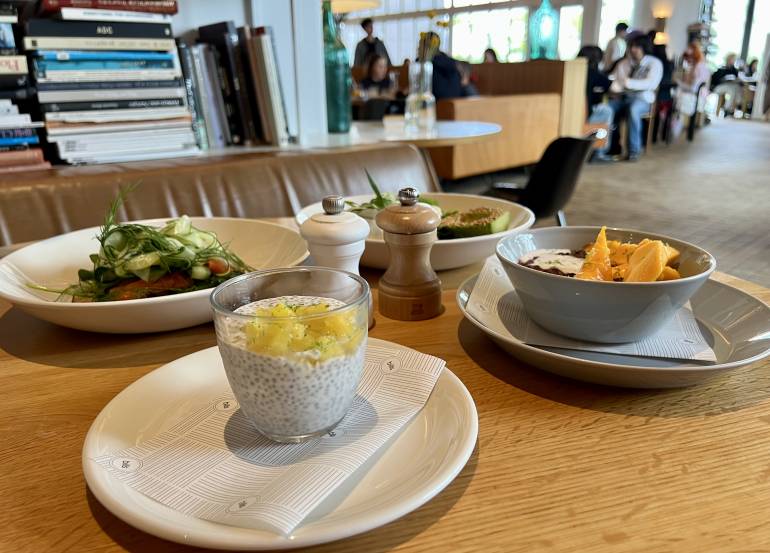
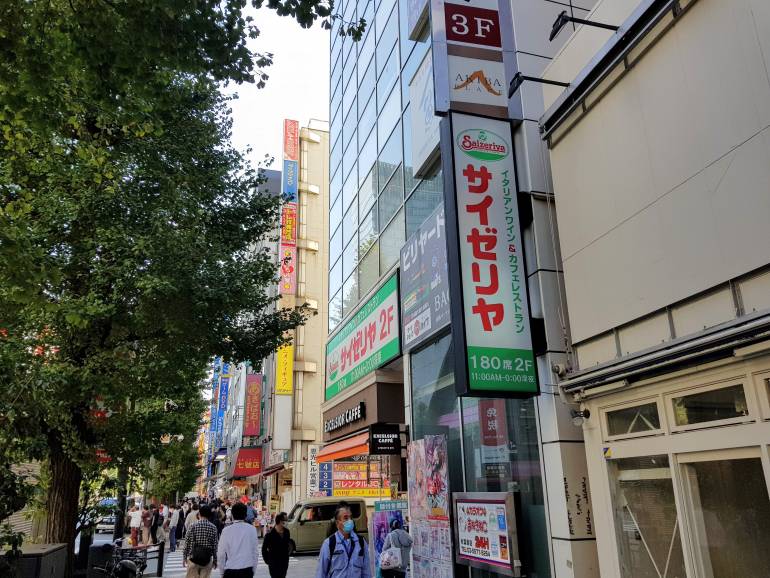
Crunching the numbers
Here are the details of some common foods and drinks. Note that these are approximate numbers, and the method of calculation for each source varies. This should not be taken as nutritional advice, but a general guide.
If viewing any Japanese source, use the auto-translate function as needed.
| Food item | Estimated net carbs | Notes | Source |
|---|---|---|---|
| Sashimi (5–6 slices) | 0–1g | Pure protein and fat. No rice and no sugar, making it ideal keto food. Wasabi is also keto-friendly. | See here and here (in Japanese). |
| Yakitori (salted, 1 skewer) | 0–2g | Salted only. Avoid tare, which adds 3–5g per skewer. | See here (in Japanese). |
| Chawanmushi (1 small cup) | 2–4g | Egg custard with dashi. Ginkgo nuts and crab stick may add sugar. | See nutritional information and recipe here, if preparing at home. |
| Miso soup (1 bowl) | 3–6g | Varies depending on other ingredients, such as clams and wakame seaweed. | See here (in Japanese). |
| Tofu (100g) | 1–2g | Plain tofu is very low in carbs. Watch soy sauce and toppings. | See here. |
| Natto (1 pack) | 4–6g | High in fibre. Sauce and mustard can add hidden sugar. | See here (in Japanese). |
| Konnyaku (1 serving) | 1g | Near-zero net carbs. Found in oden and in the form of cubes, spheres, and noodles. | See here. |
| Onigiri (1 rice ball) | 36–42g | Primarily white rice. | See here (in Japanese). |
| White rice (1 bowl) | 50–55g | Central to most meals in Japan, but best avoided on keto. | See here. |
| Udon (1 bowl cooked) | 55–60g | Refined wheat flour noodles. Very high in carbs. | See here (in Japanese). |
| Ramen noodles (100 grams) | 25–60g | Carb content goes up with broth and toppings, depending on the style you choose. | See here. |
| Soba (100% buckwheat, 1 serving cooked) | 19–21g | Lower than wheat noodles, but still high for strict keto. | See here (in Japanese). |
| Kara-age or fried chicken (3 pieces) | 4–12g | Flour or starch coating. | See here (in Japanese). |
| Tamagoyaki (100 grams) | 7–8g | Usually sweetened with sugar and mirin. | See here (in Japanese). |
| Tonkatsu (breaded pork cutlet, 100 grams) | 6–7g | Breading adds carbs. Sauce adds more carbs. | See here (in Japanese). |
Drinks
If plain water isn’t cutting it, you’ll be glad to know that Japan offers a wide range of low-carb, low-sugar drinks, many of which are easily found in vending machines and supermarkets.
As for alcohol, no diet truly recommends it. Still, it’s worth knowing your options. Also, while alcohol-free alternatives may seem like the wiser choice, they can be packed with sugary additives.
For example, we found the carb content of alcohol-free beers (around 6 to 7g per 100 ml) was, across the board, higher than that of standard beers (around 3 to 4g per 100 ml).

| Drink | Estimated net carbs | Notes | Source |
|---|---|---|---|
| Unsweetened tea (any type) | 0g | Green, barley (mugicha), oolong, black tea and beyond. Widely available and keto-safe. | See here. |
| Black coffee (hot or iced) | 0g | Watch out for added sugar. | See here. |
| Flavored soda water (no sugar) | 0g | Look for “無糖” or “ゼロ” on the label to confirm it’s sugar-free. | See here. |
| Shochu (100ml, straight or soda) | 0g | Distilled. Zero carbs. A solid keto-friendly staple in Japan. | See here (in Japanese). |
| Whisky highball | 0g | Whisky and soda water. Avoid sweetened mixes. | See here. |
| Dry red or white wine (120ml) | 2–4g | Drier varieties preferred. Dessert wines can be much higher in sugar. | See here. |
| Sake (180ml / 1 go) | 9–13g | Made from rice; varies by sweetness. Drier types slightly lower. Labels typically do not list carb content. | See here. |
| Umeshu (plum wine, 100ml) | 20–30g | Extremely sweet. High in sugar. Not keto-friendly. | See here (in Japanese) for examples. |
| Beer (1 can, 330ml) | 5–10g | Varies by type. Check labels carefully. Note that the labels list carbs per 100 ml, so you’ll need to do a bit of math to get the net carbs. | See here. |
Where to shop
Eating out can be keto-friendly with a bit of strategy. But if you’re stocking up for staying in, meal prepping at your hotel, or foraging for snacks on the go, supermarkets and convenience stores are your best bet. There’s no dedicated keto aisle, but armed with a handful of kanji and ingredient-awareness, you’ll find plenty to work with.
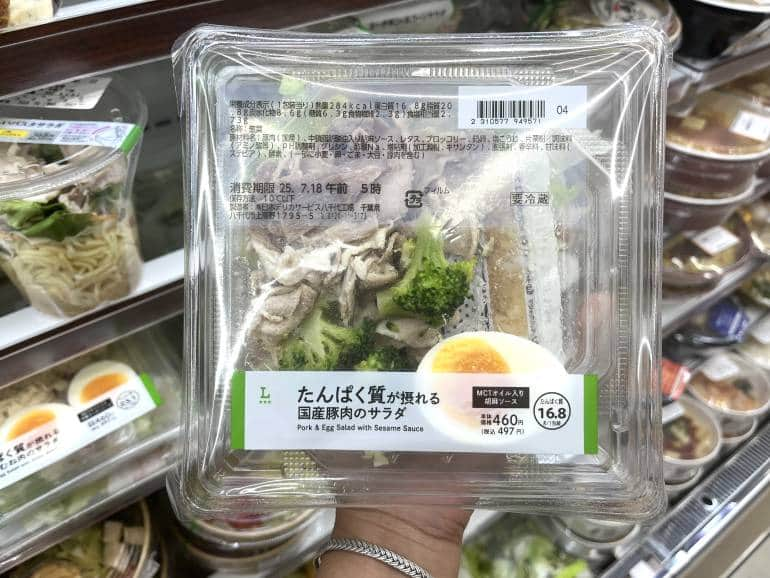
- Convenience stores: Look for boiled eggs, grilled chicken skewers, plain sausage or cheese packs, and unsweetened teas. Larger stores often stock sashimi trays. Salads are available too, often with dressing packets available for purchase separately. Steer clear of onigiri, sandwiches, noodle salads, and anything coated in breadcrumbs or sauce. And in case you’re wondering — yes, Famichiki is relatively high in carbs.
- Health food and international stores: Health food stores carry low-carb options. Our recommendations include Natural Lawson and Bio-ral.
- Supermarkets: A range of fresh protein and low-carb vegetables. Sashimi trays, roast meats, tofu, natto, and pickled vegetables are widely available. Tinned fish is a convenient protein source, but you’ll want to watch out for sweet sauces like kabayaki. Konnyaku-based foods (like shirataki noodles) are practically zero-carb. Imported items like nuts, cheeses, and sugar-free chocolate can sometimes be found at Seijo Ishii, National Azabu or other upscale supermarkets.
Pro tip: Check out our guide to import stores.
- Online shops: For specialty ingredients like almond flour, erythritol, or keto bread, consider online options, but be prepared for high prices and inconsistent stock.
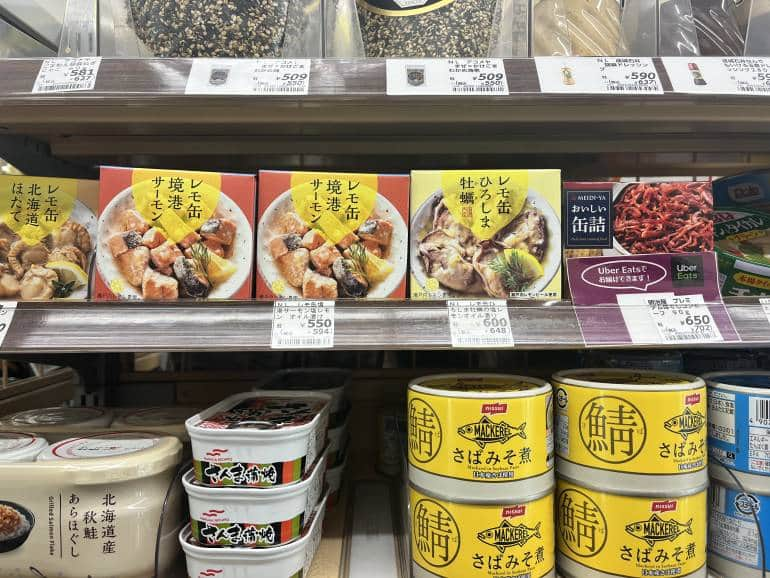
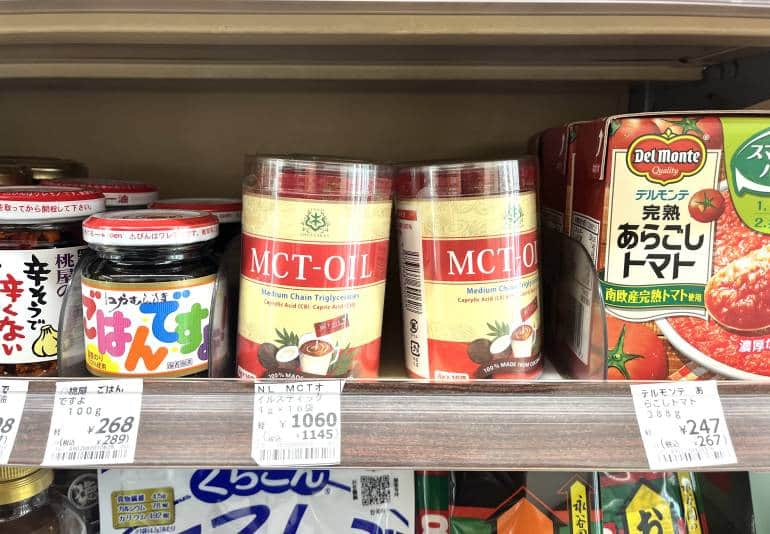
Decoding labels
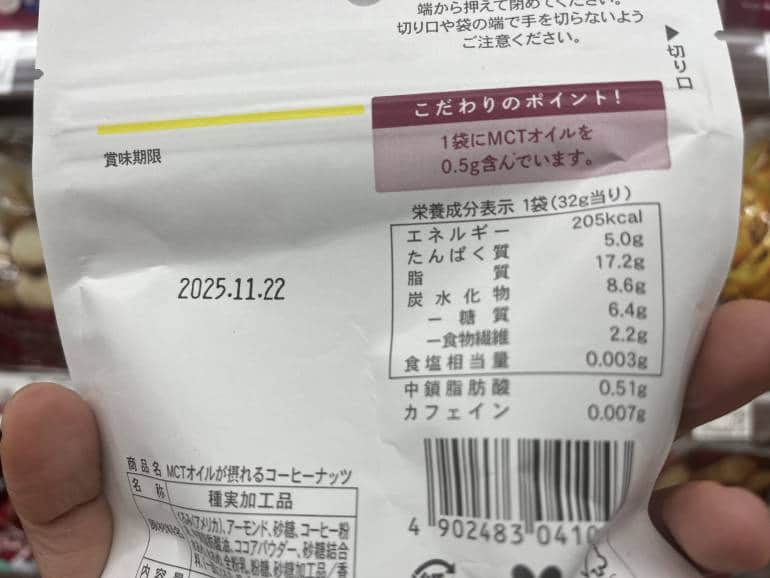
It’s hard not to be intimidated by the dense tomes of Japanese text on some food items. But fear not, checking the carb content manually isn’t too difficult — just keep these terms in mind and you’ll be good to go. Google Translate is accurate too (we tested it ourselves).
- Look for “炭水化物” (tansuikabutsu), which means carbohydrates.
- Under that, “糖質” (tōshitsu) refers to sugars, and “食物繊維” (shokumotsu sen-i) is dietary fibre.
Generally, net carbs = tansuikabutsu minus shokumotsu sen-i. For more information on calculating net carbs, check this website.
Anything with 5g or less per serving is generally safe for most keto plans. Note that common hidden sugar sources include mirin, sweet miso and teriyaki sauces.
Sample meal plan
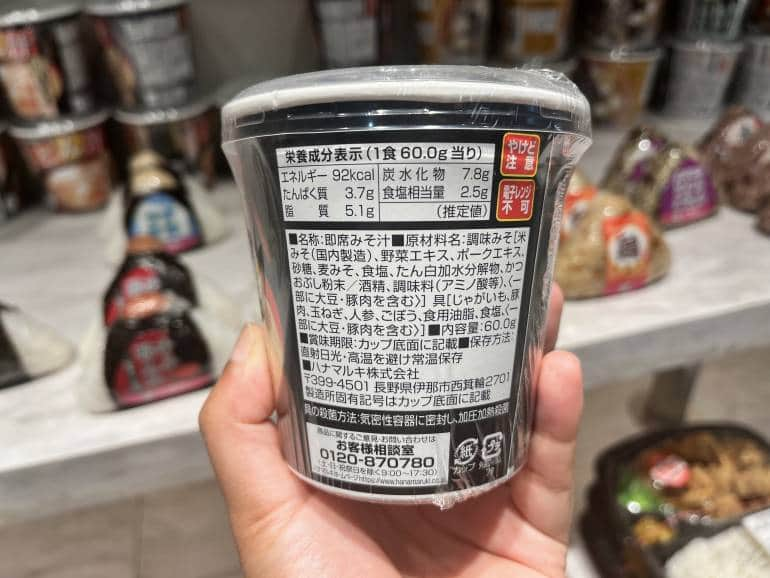
If you’re wondering what a full day of keto eating might look like in Japan, here’s a sample meal plan using common convenience-store finds, izakaya favorites, and restaurant meals. It keeps net carbs under 35g.
| Meal | What to eat | Estimated net carbs |
|---|---|---|
| Breakfast | Boiled egg, tofu, grilled fish, ham, black coffee or unsweetened green tea | 6–8g |
| Lunch | Sashimi, miso soup, side of seaweed salad and pickles | 6–10g |
| Snack | Cheese stick, nuts, meat jerky; black coffee | 5–7g |
| Dinner | Yakiniku, yakitori or shabu shabu: pork belly or short rib, offal, tofu, mushrooms, cabbage | 8–12g |
| Drink | Shochu soda or whisky highball (no additives) | 0–2g |
| Total | Daily intake | Approx. 25–35g |
Navigating tricky situations
Traditional stays

If you’re staying at ryokan or traditional Japanese inn with a breakfast and dinner plan, you will likely be served elaborate kaiseki meals with numerous, highly seasonal dishes. While some ryokan may adjust dishes if informed well in advance, flexibility is limited.
It’s best to focus on sashimi, grilled fish, tofu, soup, and vegetable dishes. Konnyaku may also be part of your meal, especially in the form of sashimi konnyaku speckled with seaweed or infused with yuzu, with a light dipping sauce of ponzu. (Fun fact: Gunma, home to hot spring havens like Kusatsu and Ikaho Onsen, is the biggest producer of konnyaku, and even boasts its own konnyaku-themed museum.)
Rice is often served at the end and it would be unusual but not rude to decline it, so it can be avoided. Dessert may be fruit or some kind of small cake or pudding — the latter may overshoot your keto threshold, so you may need to decline.
Drinking parties

A staple of working life in Japan, nomikai are structured around shared food, free-flow drinks, and social bonding. Most are held at izakaya with set course menus. These typically start with a small otoshi (mandatory appetizer), followed by items like fried chicken, potato salad, and something grilled or stewed.
The best move here is strategic eating. Grab the protein-first items: yakitori, sashimi, and grilled meat. Drink-wise, stick to highballs (whisky and soda) and shochu (especially with soda, making it a chu-hi, or water). Sake is higher in carbs, but an ochoko or two will not destroy your diet.
Set meals

Ichiju sansai (一汁三菜) is the traditional Japanese meal structure of one soup, three dishes, plus rice and pickles. Designed for variety and balance, it’s a handy framework whether you’re dining out or cooking at home. You can swap the rice out for cauli rice or simply go without.
Otherwise, teishoku (set meals) pretty much always include rice, and many main dishes available in restaurants may be breaded or sauced — think tonkatsu and hamburg steak. When possible, make a request (see below for phrases) or build a meal from à la carte items like sashimi or grilled proteins.
Helpful phrases
You don’t need to be fluent in Japanese to get your point across. Instead of getting into the nitty-gritty of keto, which the staff and others may or may not be familiar with, stick to clear, concise phrases.
- ご飯はいらないです (Gohan wa iranai desu) – I don’t need rice
- 砂糖は入っていますか? (Satō wa haitteimasu ka?) – Does this contain sugar?
- 塩だけでお願いします (Shio dake de onegaishimasu) – Just salt, please (useful for yakitori or grilled items)
- ダイエット中です (Daietto chu desu) – I’m on a diet
- Nagano, with its mountain terrain and cooler climate, has long favored soba, river fish, and wild greens.
- In Hokkaido, where rice cultivation came later, diets historically leaned on dairy, venison, and salmon.
- In Kagoshima, pork and root vegetables like taro have been staples, with rice playing a supporting role.
- In Okinawa, boasting one of the highest concentrations of centenarians and supercentenarians, the traditional diet is built more around sweet potatoes (not keto), pork, and bitter melon than rice, with a higher reliance on fats and vegetables.
Historical and regional variations

While not keto, historically, Japanese meals weren’t so carb-heavy.
Before the Meiji era (1868–1912), most ordinary Japanese people couldn’t afford to eat polished white rice at every meal. Instead, meals were built around a mix of grains like millet, barley, and buckwheat, along with wild vegetables, tofu, seaweed, small fish, and fermented soy products. Fat came from fish oils, sesame, and regional animal products.
Even today, you’ll find parts of Japan where rice plays a less central role, shaped by climate, geography, or historical trade patterns.
Properly managing your macros will likely still require a bit of effort (and a generous dose of math), but if you’re planning a trip and open to venturing outside the usual cities, some of these regional patterns help make low-carb eating more enriching and varied.
Frequently asked questions about keto in Japan
Is tofu keto?
Generally, yes. Tofu is low in net carbs, making it keto-friendly. However, you’ll want to watch out for added sauces and seasonings that may introduce carbs and sugars.
Can ramen be keto-friendly?
Ramen can be made keto-friendly. The noodles are the main culprit here, as they add considerable heft. The type of bowl you choose also makes a difference — Iekei Ramen, for example, tends to be the biggest offender. However, some shops, like the two we mentioned above, can swap regular noodles for shirataki.
Are gingko nuts keto?
Gingko nuts are quite high in carbs. See here.
Is it possible to be meat-free and still do keto?
Although challenging, it is possible. Custom salads can be a good way to go. A few top picks around town include Crisp Salad Works, Chopped Salad Day, and WithGreen.
While we do our best to ensure it’s correct, information is subject to change. We are not nutritionists, and this article should not be taken as dietary advice. Always consult with a healthcare professional before making any dietary changes.

